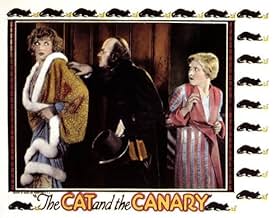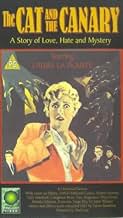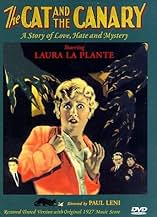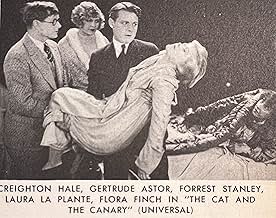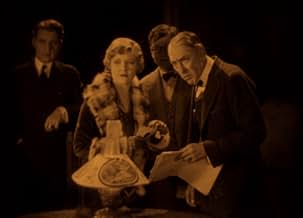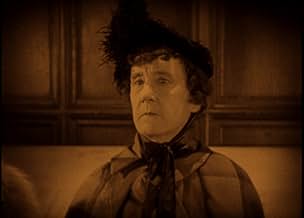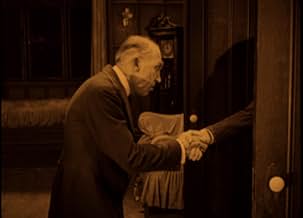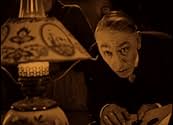CALIFICACIÓN DE IMDb
7.1/10
3.7 k
TU CALIFICACIÓN
Agrega una trama en tu idiomaRelatives of an eccentric millionaire gather in his spooky mansion on the 20th anniversary of his death for the reading of his will.Relatives of an eccentric millionaire gather in his spooky mansion on the 20th anniversary of his death for the reading of his will.Relatives of an eccentric millionaire gather in his spooky mansion on the 20th anniversary of his death for the reading of his will.
- Dirección
- Guionistas
- Elenco
- Premios
- 1 premio ganado en total
Arthur Edmund Carewe
- Harry Blythe
- (as Arthur Edmund Carew)
Billy Engle
- Taxi Driver
- (sin créditos)
Joe Murphy
- Milkman
- (sin créditos)
Opiniones destacadas
The 1922 play THE CAT AND THE CANARY was so popular that it made the fortune of author John Willard, who lived to see it filmed no fewer than three times before his death in 1942. Even today the story remains a classic of its kind, inspiring a host of films that mix comedy, mystery, and horror--not to mention still more that focus on suspicious doings in old, dark houses. When questioned by author Gavin Lambert, director James Whale very specifically indicated that the 1927 film version, along with the 1928 THE LAST WARNING, influenced his own work in such films as FRANKENSTEIN and THE OLD DARK HOUSE.
Both THE CAT AND THE CANARY and THE LAST WARNING were created for Universal by director Paul Leni. But while THE LAST WARNING is not presently available to the home market, THE CAT AND THE CANARY most certainly is, and even some eighty years later is possible to see what all the fuss was about. In term of cinematography, CAT is a remarkably imaginative film, using a series of over-lapping images, close-ups, and dissolves to astonishing effect. In a visual sense it is easily one of the most stylish films of the silent era.
The plot is a classic of its kind. Like the original Willard play, the film's story mixes a host of already-clichéd ideas with several then-new ones. Today, of course, it can be a bit difficult to them apart! But even so it remains a fair amount of fun. An eccentric millionaire has been hounded to death by his greedy relatives--and when he dies he leaves behind a will that imposes a twenty year waiting period between his death and delivery of his estate to his heir. But who will the heir be? The candidates assemble to hear the will at midnight... and no sooner is the heir named than strange doings are afoot.
The characters are archetypes: the nice girl (Laura La Plante), the mild-mannered boy (Creighton Hale), the fashion princess (Gertrude Astor), the battle ax matron (Flora Finch), and so on. Perhaps most memorable is the housekeeper (Martha Mattox), an exceedingly dour woman most ironically named Mammy Pleasant! Add in an exasperated lawyer, a creepy doctor, secret passages, hairy hands with needle-like finger nails, stolen diamonds, and as many dashes of comedy as you can get away with, mix well, and you have the inspiration for a seemingly endless list of classic films.
Although they may seem overly broad by modern standards, the cast plays at the level of what was considered comic-realistic in the late silent era, the production values are first rate, and the plot is quirky enough in a silly sort of way to make the whole thing fun. But it is really the direction and the look of the thing that scores; in its best moments, THE CAT AND THE CANARY is plenty good indeed.
The film is available in several DVD releases. You should avoid the Alpha release; although the picture is passable, the score is so dire that it completely undermines the film. Although it clearly needs further restoration, the Image release is superior and offers your choice of scores, both of which work with the film rather than against it. Recommended for silent fans and those interested in the development of the classic horror film!
Gary F. Taylor, aka GFT, Amazon Reviewer
Both THE CAT AND THE CANARY and THE LAST WARNING were created for Universal by director Paul Leni. But while THE LAST WARNING is not presently available to the home market, THE CAT AND THE CANARY most certainly is, and even some eighty years later is possible to see what all the fuss was about. In term of cinematography, CAT is a remarkably imaginative film, using a series of over-lapping images, close-ups, and dissolves to astonishing effect. In a visual sense it is easily one of the most stylish films of the silent era.
The plot is a classic of its kind. Like the original Willard play, the film's story mixes a host of already-clichéd ideas with several then-new ones. Today, of course, it can be a bit difficult to them apart! But even so it remains a fair amount of fun. An eccentric millionaire has been hounded to death by his greedy relatives--and when he dies he leaves behind a will that imposes a twenty year waiting period between his death and delivery of his estate to his heir. But who will the heir be? The candidates assemble to hear the will at midnight... and no sooner is the heir named than strange doings are afoot.
The characters are archetypes: the nice girl (Laura La Plante), the mild-mannered boy (Creighton Hale), the fashion princess (Gertrude Astor), the battle ax matron (Flora Finch), and so on. Perhaps most memorable is the housekeeper (Martha Mattox), an exceedingly dour woman most ironically named Mammy Pleasant! Add in an exasperated lawyer, a creepy doctor, secret passages, hairy hands with needle-like finger nails, stolen diamonds, and as many dashes of comedy as you can get away with, mix well, and you have the inspiration for a seemingly endless list of classic films.
Although they may seem overly broad by modern standards, the cast plays at the level of what was considered comic-realistic in the late silent era, the production values are first rate, and the plot is quirky enough in a silly sort of way to make the whole thing fun. But it is really the direction and the look of the thing that scores; in its best moments, THE CAT AND THE CANARY is plenty good indeed.
The film is available in several DVD releases. You should avoid the Alpha release; although the picture is passable, the score is so dire that it completely undermines the film. Although it clearly needs further restoration, the Image release is superior and offers your choice of scores, both of which work with the film rather than against it. Recommended for silent fans and those interested in the development of the classic horror film!
Gary F. Taylor, aka GFT, Amazon Reviewer
This is one eerie movie. That it is over 75 years old shouldn't detract from its place among "scary movies." The production values are scrumptious. The acting is a bit over the top (Aunt Susan) but all in all, an eerie night with shadows and interesting interplay among the characters. But the Paul/Annabelle relationship is a bit creepy. Aren't they (gasp!) cousins????? The hairy hand is a bit over the top too. Mammy Pleasant (is her name an inside joke?) is waaay too menacing. I saw this on TMC (loved the sepia tone) and the soundtrack is exhilarating, though a tad too fast for the action. This is a gem of a horror movie.
This is the stereotypical old dark house movie, all the relatives come to and old dark house and some one begins to kill them, or tries to. This has been remade several times, each version having its flaws and its strengths. This is the first version, and while I would like to say its the best, I can't since the silent medium has rendered its pace a bit too slow for modern audiences.
This isn't to say that its a bad film. Its not. Anyone interested in film and what can be done with it should see this film because the first half of this movie is a treasure trove of cinema techniques. The first half is also a damn good movie as well since it wonderfully sets everything up. Only as things begin to follow there course does the pacing slow. Its far from bad, it just may have you look at your watch now and again.
I give it seven out of ten, not perfect but watchable.
This isn't to say that its a bad film. Its not. Anyone interested in film and what can be done with it should see this film because the first half of this movie is a treasure trove of cinema techniques. The first half is also a damn good movie as well since it wonderfully sets everything up. Only as things begin to follow there course does the pacing slow. Its far from bad, it just may have you look at your watch now and again.
I give it seven out of ten, not perfect but watchable.
I'm a fan of both horror films and silent films, but I didn't have a chance to get around to this one until now--and I was surprised by how much I enjoyed it. Other reviewers have already indicated how well-directed it is, and some have pointed out that the "overacting" is intentional in what was always understood by 1927 audiences as a spoof of the "Old Dark House" genre that was popular on Broadway for much of the decade and spilled onto the movie screen. Once you understand that everyone KNEW these were cliches, you realize there's no reason to take a patronizing attitude. I have to say this is the most satisfying "ODH" film I've seen (not considering actual haunted house films like the first version of "The Haunting"). It has a light touch and almost every shot makes some delightful choice--moving camera, jarring close-up, dutch angle, etc. Director Leni succeeds in making this stage play seem cinematic. One shot has a frightened character speeding through the corridor, apparently on an unseen bicycle! The shot of the body falling down out of a closet onto the camera has been much imitated, both seriously (as in "Public Enemy") and as parody (Warner Bros. cartoons). For a quick comparison, check Roland West's early talkie "The Bat Whispers." Although nothing in "Cat" reaches quite the level of West's most astonishing shots, the film as a whole is more satisfying and less stagey.
I've read other user comments on this film, and I want to add my own. "The Cat and The Canary" is one of those films that is often spoken about as being one of the classic horror films of the silent era, and after watching this film it is easy to see why.
From the opening sequence, of a hand brushing away dust and cobwebs to reveal the films title, to the closing shot, the film is very spooky. Yes, I will say that at times the film is almost too spooky, and that some of the acting is overdone.
The plot of the film is simple: 20 years after a wealthy and thought to be insane man has died, his family gathers to read the contents of his will.
Those who see this film will see all types of cliches in the horror movie genre, hidden panels, hands reaching out from behind walls, creepy shadows, but the interesting thing to note is that this film was among the first to use these effects, in other words you are seeing these things occur before they became commonplace.
This was an early horror film made by Universal Pictures, fresh on the success of other classic Universal horror films like Phantom of the Opera and Hunchback of Notre Dame.
The director of this film, Paul Leni, was German, and the film directly relates that. This film is a classic example of how German filmmaking influenced American films. If you like this film, and especially the camera style, stylish sets, and the general modd and feel of the film, take a look at other German silent films, and you will love them as well.
This film is now Public Domain, and is available on DVD and VHS from several companies. IMDB lists its length in the 80 minute range, however the version I saw, with a new score is 101 minutes long. I highly reccomend this film.
From the opening sequence, of a hand brushing away dust and cobwebs to reveal the films title, to the closing shot, the film is very spooky. Yes, I will say that at times the film is almost too spooky, and that some of the acting is overdone.
The plot of the film is simple: 20 years after a wealthy and thought to be insane man has died, his family gathers to read the contents of his will.
Those who see this film will see all types of cliches in the horror movie genre, hidden panels, hands reaching out from behind walls, creepy shadows, but the interesting thing to note is that this film was among the first to use these effects, in other words you are seeing these things occur before they became commonplace.
This was an early horror film made by Universal Pictures, fresh on the success of other classic Universal horror films like Phantom of the Opera and Hunchback of Notre Dame.
The director of this film, Paul Leni, was German, and the film directly relates that. This film is a classic example of how German filmmaking influenced American films. If you like this film, and especially the camera style, stylish sets, and the general modd and feel of the film, take a look at other German silent films, and you will love them as well.
This film is now Public Domain, and is available on DVD and VHS from several companies. IMDB lists its length in the 80 minute range, however the version I saw, with a new score is 101 minutes long. I highly reccomend this film.
¿Sabías que…?
- TriviaWriter/director Robert F. Hill not only wrote the adaptation for this film but also served as a sort of assistant/associate director for Paul Leni. Leni, a German, didn't speak much English, and Hill spoke German, so he acted as a liaison between Leni and the cast and crew.
- ErroresAs Tully Marshall's dead body falls to the floor, the actor can be clearly seen extending his hands to break the fall.
- Citas
Roger Crosby: I have come to read the will of Cyrus West. Have any of the heirs arrived yet?
Mammy Pleasant: No, Mr. Crosby.
Roger Crosby: You must have been lonely here these twenty years, Mammy Pleasant.
Mammy Pleasant: I don't need the living ones.
- Créditos curiososThe ending cast list includes the following statement: "This is repeated at the request of picture patrons who desire to check the names of those players whose work has pleased them."
- Versiones alternativasKino International distributed a video with the original 1927 musical setting compiled by James Bradford and adapted and performed by Eric Beheim and "The Cyrus West Players." It was produced by David Shepard using film materials from the David Bradley collection, and copyrighted in 1997 by Film Preservation Associates. The running time was 82 minutes.
- ConexionesEdited into Histoire(s) du cinéma: Seul le cinéma (1994)
- Bandas sonorasSymphony No. 3 in C minor Op. 78 'Organ' I. Adagio
Written by Camille Saint-Saëns
Selecciones populares
Inicia sesión para calificar y agrega a la lista de videos para obtener recomendaciones personalizadas
- How long is The Cat and the Canary?Con tecnología de Alexa
Detalles
- Fecha de lanzamiento
- País de origen
- Idiomas
- También se conoce como
- The Cat and the Canary
- Locaciones de filmación
- Productora
- Ver más créditos de la compañía en IMDbPro
Taquilla
- Total en EE. UU. y Canadá
- USD 709,699
- Tiempo de ejecución
- 1h 48min(108 min)
- Color
- Mezcla de sonido
- Relación de aspecto
- 1.33 : 1
Contribuir a esta página
Sugiere una edición o agrega el contenido que falta

